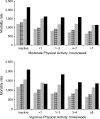Joint associations of adiposity and physical activity with mortality: the National Institutes of Health-AARP Diet and Health Study
- PMID: 19372216
- PMCID: PMC2800254
- DOI: 10.1093/aje/kwp053
Joint associations of adiposity and physical activity with mortality: the National Institutes of Health-AARP Diet and Health Study
Abstract
The authors examined the joint associations of adiposity (assessed by body mass index (BMI; weight (kg)/height (m)(2)) and waist circumference) and physical activity with mortality to evaluate whether physical activity protects against the adverse effects of high adiposity. Using data on 185,412 men and women aged 51-72 years participating in the National Institutes of Health-AARP Diet and Health Study, the authors assessed all-cause mortality over 10 years (1996-2006). Overweight (BMI 25-<30), obesity (BMI > or =30), a large waist circumference (men: > or =102 cm; women: > or =88 cm), and low physical activity were each independent predictors of mortality. Compared with normal-weight persons (BMI 18.5-<25) who were physically active (>7 hours/week of moderate physical activity), mortality risks were 1.62 (95% confidence interval (CI): 1.50, 1.75) for inactive normal-weight persons, 1.79 (95% CI: 1.37, 2.33) for active morbidly obese (BMI > or =35) persons, and 3.45 (95% CI: 2.79, 4.00) for inactive morbidly obese persons. Similar results were found for the combined relation of BMI and vigorous physical activity. Inactive persons with a large waist circumference had 2 times' greater mortality risk than active persons with a normal waist circumference. High physical activity attenuated but did not eliminate the increased mortality risk associated with obesity. Preventing weight gain and promoting physical activity in older persons may lower mortality risk.
Figures

 , 18.5–<25 (normal-weight);
, 18.5–<25 (normal-weight);  , 25–<30 (overweight);
, 25–<30 (overweight);  , 30–<35 (obese);
, 30–<35 (obese);  , ≥35 (morbidly obese).
, ≥35 (morbidly obese).
 , group 1 (men <94 cm, women <80 cm);
, group 1 (men <94 cm, women <80 cm);  , group 2 (men 94–<102 cm, women 80–<88 cm);
, group 2 (men 94–<102 cm, women 80–<88 cm);  , group 3 (men 102–<110 cm, women 88–<96 cm);
, group 3 (men 102–<110 cm, women 88–<96 cm);  , group 4 (men ≥110 cm, women ≥96 cm).
, group 4 (men ≥110 cm, women ≥96 cm).References
-
- Katzmarzyk PT, Church TS, Janssen I, et al. Metabolic syndrome, obesity, and mortality: impact of cardiorespiratory fitness. Diabetes Care. 2005;28(2):391–397. - PubMed
-
- Church TS, LaMonte MJ, Barlow CE, et al. Cardiorespiratory fitness and body mass index as predictors of cardiovascular disease mortality among men with diabetes. Arch Intern Med. 2005;165(18):2114–2120. - PubMed
-
- Hu FB, Willett WC, Li T, et al. Adiposity as compared with physical activity in predicting mortality among women. N Engl J Med. 2004;351(26):2694–2703. - PubMed
-
- Hu G, Tuomilehto J, Silventoinen K, et al. The effects of physical activity and body mass index on cardiovascular, cancer and all-cause mortality among 47 212 middle-aged Finnish men and women. Int J Obes (Lond) 2005;29(8):894–902. - PubMed
-
- Stevens J, Evenson KR, Thomas O, et al. Associations of fitness and fatness with mortality in Russian and American men in the Lipids Research Clinics Study. Int J Obes Relat Metab Disord. 2004;28(11):1463–1470. - PubMed

